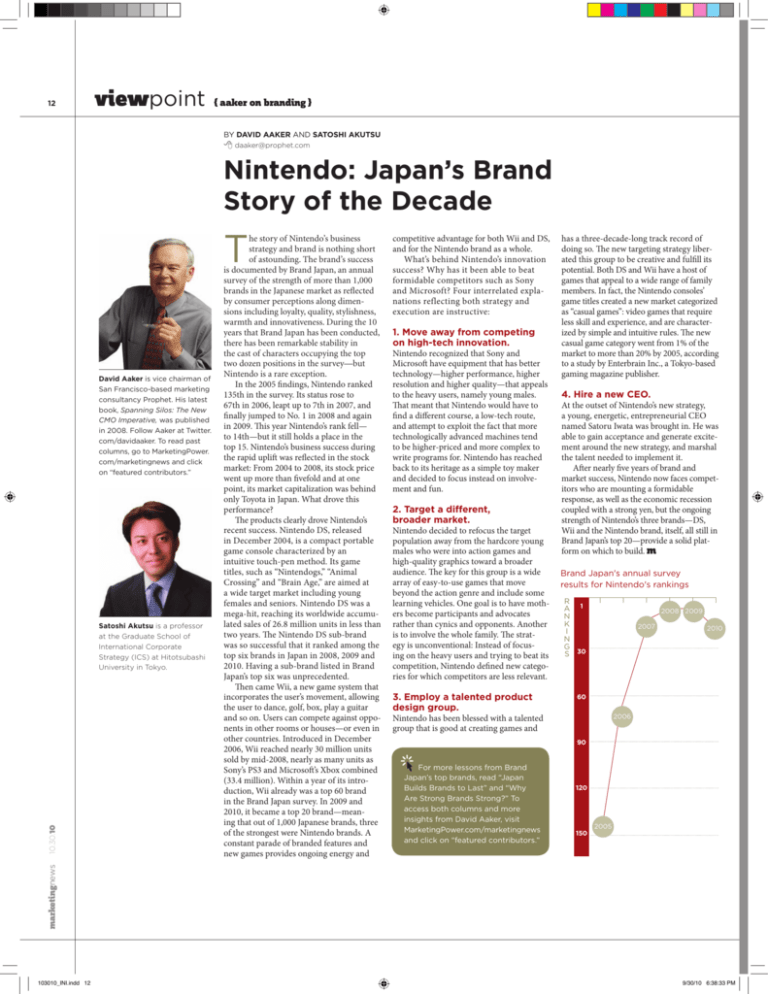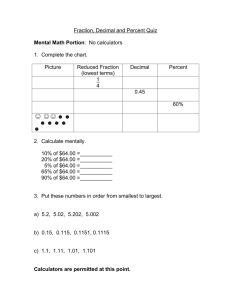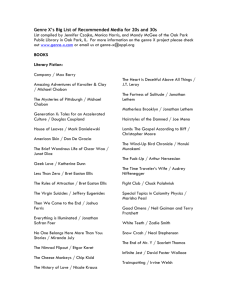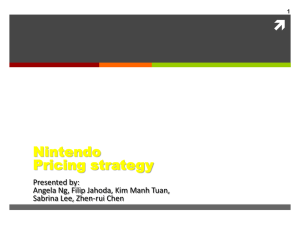Nintendo: Japan's Brand Story of the Decade
advertisement

12
viewpoint
{ aaker on branding }
By David Aaker and Satoshi Akutsu
daaker@prophet.com
Nintendo: Japan’s Brand
Story of the Decade
T
David Aaker is vice chairman of
San Francisco-based marketing
consultancy Prophet. His latest
book, Spanning Silos: The New
CMO Imperative, was published
in 2008. Follow Aaker at Twitter.
com/davidaaker. To read past
columns, go to MarketingPower.
com/marketingnews and click
on “featured contributors.”
marketingnews 10.30.10
Satoshi Akutsu is a professor
at the Graduate School of
International Corporate
Strategy (ICS) at Hitotsubashi
University in Tokyo.
103010_INI.indd 12
he story of Nintendo’s business
strategy and brand is nothing short
of astounding. The brand’s success
is documented by Brand Japan, an annual
survey of the strength of more than 1,000
brands in the Japanese market as reflected
by consumer perceptions along dimensions including loyalty, quality, stylishness,
warmth and innovativeness. During the 10
years that Brand Japan has been conducted,
there has been remarkable stability in
the cast of characters occupying the top
two dozen positions in the survey—but
Nintendo is a rare exception.
In the 2005 findings, Nintendo ranked
135th in the survey. Its status rose to
67th in 2006, leapt up to 7th in 2007, and
finally jumped to No. 1 in 2008 and again
in 2009. This year Nintendo’s rank fell—
to 14th—but it still holds a place in the
top 15. Nintendo’s business success during
the rapid uplift was reflected in the stock
market: From 2004 to 2008, its stock price
went up more than fivefold and at one
point, its market capitalization was behind
only Toyota in Japan. What drove this
performance?
The products clearly drove Nintendo’s
recent success. Nintendo DS, released
in December 2004, is a compact portable
game console characterized by an
intuitive touch-pen method. Its game
titles, such as “Nintendogs,” “Animal
Crossing” and “Brain Age,” are aimed at
a wide target market including young
females and seniors. Nintendo DS was a
mega-hit, reaching its worldwide accumulated sales of 26.8 million units in less than
two years. The Nintendo DS sub-brand
was so successful that it ranked among the
top six brands in Japan in 2008, 2009 and
2010. Having a sub-brand listed in Brand
Japan’s top six was unprecedented.
Then came Wii, a new game system that
incorporates the user’s movement, allowing
the user to dance, golf, box, play a guitar
and so on. Users can compete against opponents in other rooms or houses—or even in
other countries. Introduced in December
2006, Wii reached nearly 30 million units
sold by mid-2008, nearly as many units as
Sony’s PS3 and Microsoft’s Xbox combined
(33.4 million). Within a year of its introduction, Wii already was a top 60 brand
in the Brand Japan survey. In 2009 and
2010, it became a top 20 brand—meaning that out of 1,000 Japanese brands, three
of the strongest were Nintendo brands. A
constant parade of branded features and
new games provides ongoing energy and
competitive advantage for both Wii and DS,
and for the Nintendo brand as a whole.
What’s behind Nintendo’s innovation
success? Why has it been able to beat
formidable competitors such as Sony
and Microsoft? Four interrelated explanations reflecting both strategy and
execution are instructive:
1. Move away from competing
on high-tech innovation.
Nintendo recognized that Sony and
Microsoft have equipment that has better
technology—higher performance, higher
resolution and higher quality—that appeals
to the heavy users, namely young males.
That meant that Nintendo would have to
find a different course, a low-tech route,
and attempt to exploit the fact that more
technologically advanced machines tend
to be higher-priced and more complex to
write programs for. Nintendo has reached
back to its heritage as a simple toy maker
and decided to focus instead on involvement and fun.
2. Target a different,
broader market.
Nintendo decided to refocus the target
population away from the hardcore young
males who were into action games and
high-quality graphics toward a broader
audience. The key for this group is a wide
array of easy-to-use games that move
beyond the action genre and include some
learning vehicles. One goal is to have mothers become participants and advocates
rather than cynics and opponents. Another
is to involve the whole family. The strategy is unconventional: Instead of focusing on the heavy users and trying to beat its
competition, Nintendo defined new categories for which competitors are less relevant.
3. Employ a talented product
design group.
has a three-decade-long track record of
doing so. The new targeting strategy liberated this group to be creative and fulfill its
potential. Both DS and Wii have a host of
games that appeal to a wide range of family
members. In fact, the Nintendo consoles’
game titles created a new market categorized
as “casual games”: video games that require
less skill and experience, and are characterized by simple and intuitive rules. The new
casual game category went from 1% of the
market to more than 20% by 2005, according
to a study by Enterbrain Inc., a Tokyo-based
gaming magazine publisher.
4. Hire a new CEO.
At the outset of Nintendo’s new strategy,
a young, energetic, entrepreneurial CEO
named Satoru Iwata was brought in. He was
able to gain acceptance and generate excitement around the new strategy, and marshal
the talent needed to implement it.
After nearly five years of brand and
market success, Nintendo now faces competitors who are mounting a formidable
response, as well as the economic recession
coupled with a strong yen, but the ongoing
strength of Nintendo’s three brands—DS,
Wii and the Nintendo brand, itself, all still in
Brand Japan’s top 20—provide a solid platform on which to build. m
Brand Japan's annual survey
results for Nintendo's rankings
R
a 1
n
k
i
n
g
s 30
2008 2009
2007
2010
60
Nintendo has been blessed with a talented
group that is good at creating games and
2006
90
For more lessons from Brand
Japan’s top brands, read “Japan
Builds Brands to Last” and “Why
Are Strong Brands Strong?” To
access both columns and more
insights from David Aaker, visit
MarketingPower.com/marketingnews
and click on “featured contributors.”
120
150
2005
9/30/10 6:38:33 PM




